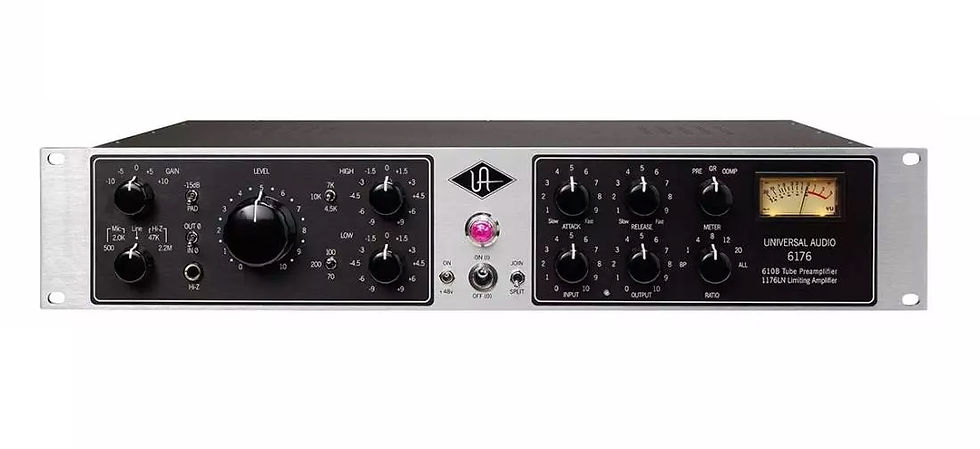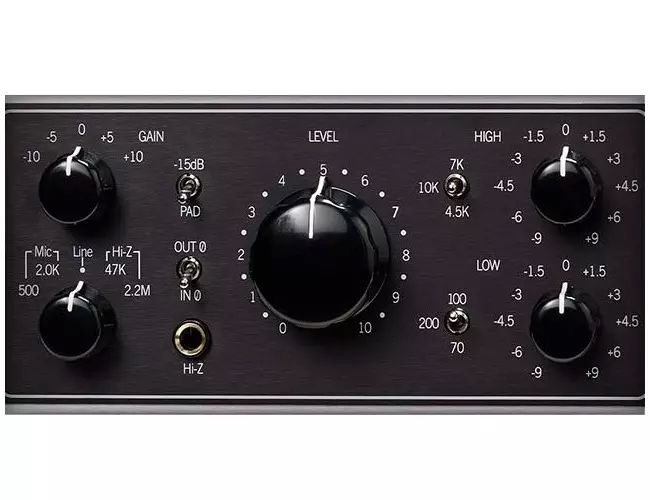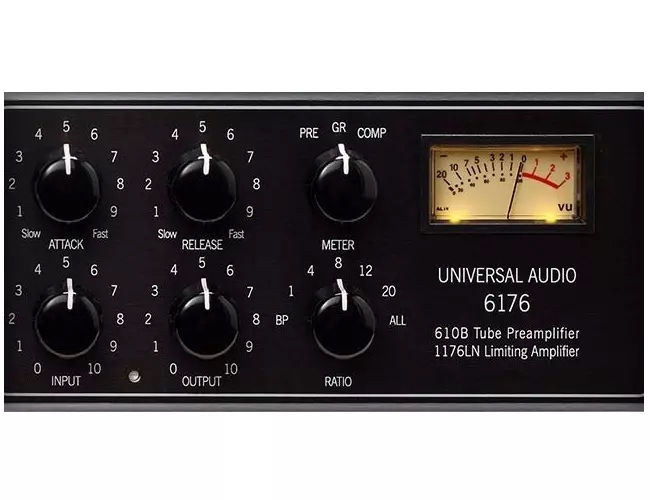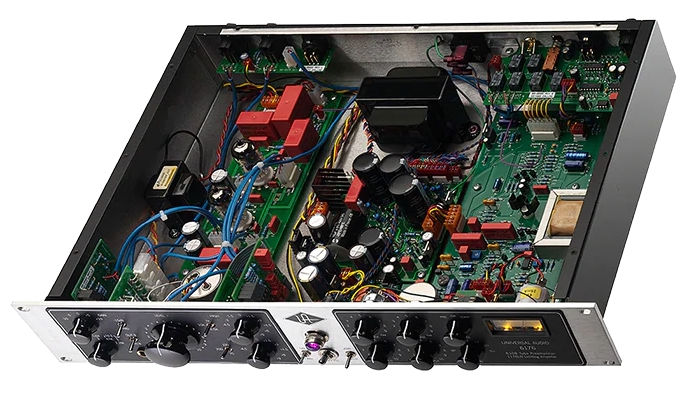Why You May Want to Consider the UA 6176
- Pat Wright

- Aug 13
- 5 min read
Opinions—everyone’s got one. At L&M Pro, we field a lot of recording gear questions, especially about channel strips: which ones to get, what they sound like, and how they fit into different workflows. Whether you're making your first purchase or adding to a professional rig, these are questions we hear all the time.
Epistemology Meets Audio Gear
Like anything in life, recording is a journey. It's about learning, experimenting, and always evolving. That’s why we believe the knowledge we’ve gained—through hands-on experience and research—should be shared. In this article, we’ll offer insights we hope will help you better understand one of our favorite pieces of gear: the Universal Audio 6176.
What Is the UA 6176 Channel Strip?


Universal Audio created something truly special with this unit.
“The 610-B (as found in the LA-6176) was inspired by the microphone preamp section of the original 610 console designed by UA founder, M.T. "Bill" Putnam, in 1960. The 610 custom consoles, which included the 610-A preamp and EQ modules, were the first consoles of a modular design. Although technologically simple compared to modern consoles, those 610 consoles possessed a warmth and character that kept them in demand for decades.” — Universal Audio

On the left side of the 6176, you’ve got the 610-B tube mic pre with EQ tone-shaping options, selectable input impedance (500 & 2K), line input, and (47k & 2.2M) Hi-Z inputs. The Hi-Z input, in particular, is fantastic as a direct input for electric bass.

On the right side sits the legendary 1176LN compressor. The circuit is based on the D and E revisions—widely considered the best-sounding and quietest iterations. You get all the usual offerings: ratio, attack, release, input/output gain controls, and more.
A Hidden Feature That Doubles Your Options

But here’s where it gets really interesting: flip the “Join” switch off, and the unit becomes two independent pieces—a standalone tube mic pre and a standalone compressor. Even better, if you turn the Attack knob all the way counterclockwise until it clicks, the right-hand side becomes a FET dynamic mic preamp. (No 48V phantom power on this side, though—but that’s easily solved with an external phantom box like the Radial StageBug SB-48.)

So, what you actually have is four tools in one:
A full channel strip
A tube mic preamp
An 1176 compressor
A FET mic preamp
That’s some serious flexibility packed into a single unit.
But Does the Strip Really Matter?

Let’s tackle a common myth: Some say that once vocals are layered, doubled, and processed, the original sound of the channel strip gets lost in the mix. If that were true, why bother with any channel strip at all? Wouldn't one universal strip suffice for every track?
That kind of thinking is reductive. It's like saying all cars are the same because they all get you from A to B. Channel strips bring unique tone and character—and that absolutely affects the sound, vibe, and emotion of a performance.
Let’s scrap the idea that "it doesn’t matter" and be real—channel strips make a huge difference, and the 6176 is one of the most versatile and sonically pleasing options out there.
Why the 6176? Why Now?

Here’s one big reason I wanted to write about the 6176: it’s arguably one of the most accessible high-end strips on the market, especially at Long & McQuade. You can often find a used or demo unit available in your local shop, which also means you can rent one almost anytime for a session or trial.
That’s rare at this level—the 6176 retails at $4999, and many other units in that price range simply aren’t rentable. Having access to this caliber of gear when you need it most—say, to capture a crucial vocal take—is a game-changer.
Just Follow Your Ears
One of the best things about the 6176 is how easy it is to find real-world examples of its use. I always say: hearing is believing. If you want to know what it sounds like, go listen to the tracks it's been used on. There's a good chance you already love some of them.
Here are just a few artists and engineers who’ve used the 6176, the 610 mic pre, and the 1176LN: Vance Powell, Joe Chiccarelli, Rik Simpson, Chris Martin (Coldplay), Norah Jones, Wyclef Jean, James Mercer (The Shins), Adele, Pharrell, Frank Sinatra, and Nat King Cole.
“A prominent component of Putnam’s United/Western Studios in Los Angeles, the 610 was used on many classic recordings by Frank Sinatra and Sarah Vaughan, as well as records like the Beach Boys' Pet Sounds and the Doors' LA Woman. The extensive live recordings made with Wally Heider's 610 ‘Green Board’ include records by Duke Ellington, Elvis Presley, Johnny Cash (At Folsom Prison), Cream, The Who, The Grateful Dead, The Byrds, Jefferson Airplane, Booker T. & the M.G.s, Otis Redding, Eric Burdon and The Animals, Simon and Garfunkel, and The Jimi Hendrix Experience. The desk was then bought by Neil Young and has been used on his records ever since.” — Universal Audio

Links to specific recordings and uses:
Chris Martin - https://equipboard.com/submissions/275370
Steve Lukather - https://equipboard.com/submissions/277087
Sturgill Simpson - https://equipboard.com/submissions/286929
Rival Consoles - https://equipboard.com/submissions/22893
Alan Parsons - https://equipboard.com/submissions/189143
Colour vs. Transparency
This debate is, admittedly, subjective—but let’s be honest: if you're recording modern genres like indie, R&B, rap, rock, or country, you're probably looking for some coloration and saturation. Today's audio interfaces are extremely clean, sometimes too clean. The 6176 adds rich harmonics and warmth that give recordings depth.
Prefer something ultra-transparent? You might be looking more at Millennia STT-1 or Grace Designs gear for orchestral or classical work.
Want to get gritty? Use the 6176 as a distortion box. Disable the “Join” switch, turn the Attack knob counterclockwise until it clicks, this disables the compressor, and crank the gain until you hit your saturation sweet spot.
Want clean and warm? Use it conservatively, and it’ll reward you with beautifully transparent results—great for large-diaphragm dynamics and more.
Final Thoughts & Future Pathways

If I had to pick just one all-rounder to capture vocals, DI bass, acoustic guitars, or piano, the 6176 would be at the top of the list. For the downtown condo producer, voice-over studio, or multi-genre engineer, this thing just delivers.
Sure, there are other great units—like the Manley Core or the RND Shelford Channel—but for me, the 6176 hits the sweet spot. It's a classic, it’s flexible, and yes… I need some tubes in my life.
Looking for a great piece to contrast? Maybe the API TCS-II, especially if you want to add a fast punchy a solid-state counterpart.
As always: research, listen, and match the gear to your workflow and genre.
Care To Plug-In?


The UA 6176 is now available as one of UA’s Unison Impedance modelling plug-ins and can be purchased/financed from us here at L&M Pro, or you can of course purchase directly through UA online. Bonus is that plug-in also doubles as the iconic LA-610!
Curious? Come See Us
If this post has piqued your curiosity about adding a 6176 to your setup, give us a shout at L&M Pro:
📞 416-928-6434📍 935 Bloor St West, Toronto





Comments